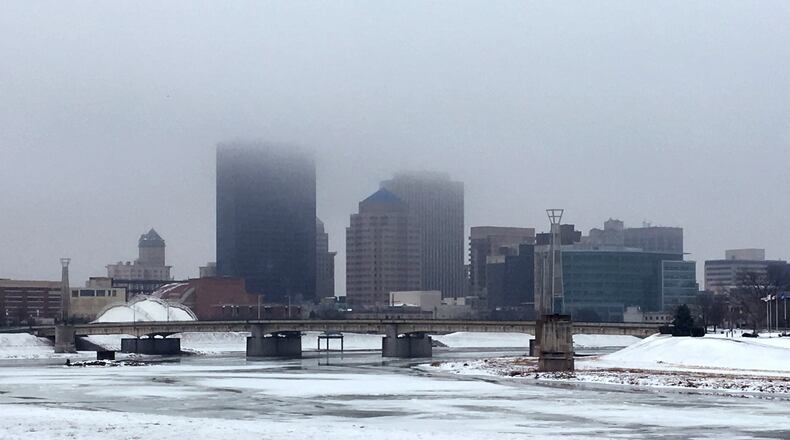Natural gas delivery volume in its Ohio service territory since Dec. 15, 2017, is the second highest Vectren has seen, said Natalie Hedde, spokeswoman for the Evansville, Ind.-based company.
RELATED: Opponents say Senate bill would raise DP&L rates
Expect bills to be about 30 percent higher than the comparable period last year, she warned.
“Extreme temperatures the last half of December 2017 through the first half of January this year have led to gas usage in volumes which rival the highest ever seen,” the company said in a release.
Gas is delivered to 316,000 customers in West-Central Ohio through Vectren’s 5,500-mile pipeline network.
Duke Energy and Columbia Gas also expect higher bills for customers.
MORE: PR or investment? Walmart joins companies awarding raises, bonuses
Kelli Nowinsky, a spokeswoman for Columbia Gas of Ohio, which serves the Springfield area, said natural gas prices are down, but temperatures are much colder than average, so bills will be higher.
Natural gas prices for January are down about 28 percent compared to January 2017, but Columbia expects weather colder than last year to take its toll.
“We estimate the January bill for the average customer will be about $20 higher than normal ($135.45 with our cold weather vs. $116.15 with normal weather),” Nowinsky said. “But every customer is different; customers who use more gas could see a much bigger jump in their bill.”
RELATED: Toyota, Mazda said to eye Alabama for 4,000 jobs
Lee Freedman, a Cincinnati-based spokesman for North Carolina-based Duke Energy, which serves customers in Warren County and beyond, agrees that cold has an impact.
“Remember that last year and the year before, we had really mild winters,” he said. “So compared to the mild winters, yes, it’s going to be extreme. Compared to average winters, it will probably higher (than those), too.”
Over the past month, Duke Energy customers have used more natural gas than average, but have not set any records in terms of use, Freedman said.
RELATED: Fifth Third awards $75K total to Dayton non-profits
In Southwestern Ohio and Northern Kentucky, Duke Energy is projected to deliver 18.7 billion cubic feet of natural gas from Dec. 15, 2017, to Jan. 15, 2018, Duke said recently. That’s up from 14.3 billion cubic feet (Bcf) for the same period last year.
The Duke record: In 1994, Duke customers used more than 20 Bcf of natural gas during a 30-day period.
What’s different about the stretch from Dec. 15 to expected weather through Jan. 15, 2018, is the sheer duration of all that cold, Vectren’s Hedde said.
RELATED: Sam's Club locations reportedly closing without notice
“If you think back to events like the polar vortex, it was cold, certainly,” Hedde said. “This (the immediate past month) was interesting because in this time period, there wasn’t winter weather in terms of accumulation and precipitation as part of that story. It was just the bitter, bitter cold.”
If you’re worried about costs, Vectren suggests calling at (800) 227-1376. Qualifying customers can set up a payment schedule whereby they can pay their bills in smaller increments over a set period of time, the company said.
This is a free service with no interest charges, Vectren said.
“We definitely want to partner with customers just as soon as they find themselves in a challenge to pay,” Hedde said.
MORE: Opponents say Senate bill would raise DP&L rates
Worried about your gas service being cut off? Hedde noted that the company is in what she called a “moratorium period” from shutting service down.
“We will work with each individual customer, depending on qualifications, certainly during extreme temperatures,” she said. “There are some unwritten rules where we would not disconnect.”
Wallace Tyner, an agriculture professor at Purdue University and an expert on natural gas, said what people need to understand and often don’t, is that a gas bill consists of two factors — the price of gas and the quantity of gas used. In cold weather, the quantity (or demand) side of the equation goes up, he said.
Utilities should have “forward-priced” natural gas last summer, Tyner said. Gas in our part of the country is injected underground and stored under salt domes, injected all through summer until about October or so, he said.
“Withdrawals (of natural gas) this year have been higher than in the past, obviously,” Tyner said. “That’s the ‘q’ (quantity) side of the equation.”
The price of the gas should be stable. But it could be higher next summer, especially if the cold weather continues, Tyner said. It could be as much as eight percent higher next year, he estimated.
Even with continued cold, though, supply of gas in this part of the country should remain stable, he said. That’s a bit less certain in areas like the Northeastern United States, he also said.
By the numbers
More than 1 million: Total Vectren customers in two-thirds of Indiana and West Central Ohio.
580,000: Vectren North customers in Indiana.
About 314,000: Vectren Energy Delivery of Ohio customers
144,000: Vectren South customers, also in Indiana.
Plus another 110,000 customers.
Source: Vectren.
About the Author



